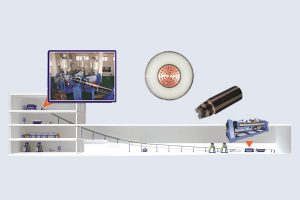The Chemical Essence of Crosslinking: What is “Crosslinking”?
Crosslinking is a chemical process where polyethylene (PE) polymer chains bond with each other through covalent links—typically carbon-carbon (C-C) bonds—to form a three-dimensional network. Linear PE consists of independent polymer chains, while crosslinked PE (XLPE) forms an interconnected matrix, enhancing thermal, mechanical, and chemical stability, making it suitable for high-temperature and high-stress applications.

Comparison of Crosslinking Processes: Chemical vs. Irradiation Crosslinking
There are two mainstream crosslinking techniques used in XLPE cable production: chemical crosslinking and irradiation crosslinking. Chemical crosslinking involves adding peroxides or silane compounds that, when activated by heat or moisture, initiate bond formation between PE chains. Irradiation crosslinking uses high-energy electron beams to break bonds and generate reactive sites for network formation. While chemical methods allow adjustable crosslinking rates and are widely used in medium and high-voltage cables, irradiation provides cleaner processing and better uniformity but requires higher capital investment and is more common in low-voltage applications.
| Process | Method | Advantages | Disadvantages |
|---|---|---|---|
| Chemical Crosslinking | Peroxide or Silane Additives | Well-established, scalable, tunable crosslink density | Requires heating and post-curing, may release by-products |
| Irradiation Crosslinking | Electron Beam | No chemicals, fast processing, consistent structure | High equipment cost, limited to thinner cable sections |
Temperature resistance comparison by process:
| XLPE Type | Continuous Operating Temperature (°C) | Short-term Overload Temperature (°C) |
|---|---|---|
| Peroxide Crosslinked XLPE | 90 | 130 |
| Silane Crosslinked XLPE | 85 | 120 |
| Irradiation Crosslinked XLPE | 105 | 150 |
Correspondence Between Crosslinking Degree and Temperature Rating
The crosslinking degree—typically expressed as gel content percentage—is a key determinant of a material’s thermal resilience. A higher crosslink density implies stronger molecular entanglement and higher resistance to deformation under heat. For instance, XLPE samples with 65%, 75%, and 85% crosslinking degrees were tested at 135°C for 168 hours. Their residual tensile strength retention was measured at 70%, 85%, and 92%, respectively. IEC 60502-1 recommends a minimum of 75% gel content for reliable performance under thermal stress. Additionally, higher crosslinking improves elongation at break and reduces the rate of thermal aging, extending cable lifespan in demanding environments.
Misleading Temperature Ratings: Long-Term Operating vs. Short-Term Overload
Temperature ratings can be misunderstood. For example, a UL 125°C-rated cable is designed for continuous use at 125°C but can tolerate up to 150°C in short bursts. However, prolonged exposure to 150°C would accelerate degradation, reduce flexibility, and potentially cause insulation cracking, leading to premature failure if not properly accounted for in design or specification.
Importance of Selecting the Crosslinking Process Based on the Application Environment
In a wind energy project in northern China, sub-zero temperatures caused thermal contraction in insulation layers of cables with insufficient crosslinking. The contraction pulled the insulation away from the conductor, eventually leading to dielectric breakdown and short circuits. This failure highlights the critical need to match the crosslinking method and degree with environmental and mechanical stresses specific to the project location.
Conclusion and Recommendations
Choose XLPE cables with at least 75% crosslinking degree, and match the crosslinking method to your application environment. Verify certifications and request data on gel content and thermal aging performance.




